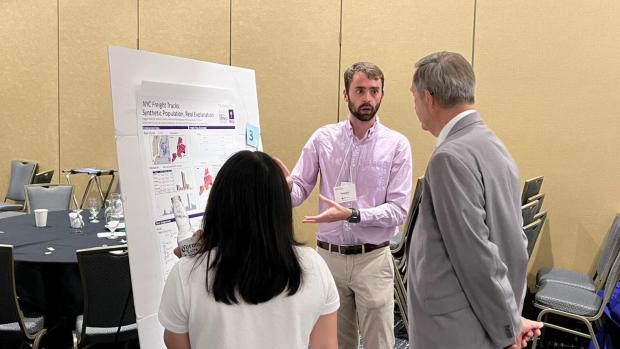Tandon’s transportation research stands out at major ITS-NY event

Ph.D. candidate Haggai Davis III received first-place honors for his poster presentation
The Intelligent Transportation Society of New York (ITS-NY) recently held its 30th annual meeting, and among the highlights of the event, which featured respected speakers such as the commissioners of both the city and state Departments of Transportation, was the technology exhibition. This year’s theme was “A Connected World,” and on-hand to explain their research were students from C2SMART (NYU Tandon’s USDOT Tier 1 University Transportation Center) — fitting since the C in its acronym stands for “connected.” (Its full name is Connected Cities with Smart Transportation.)
When the multi-day conference culminated, three students had been honored for their visionary presentations, which touched upon ways to keep pedestrians and drivers safer, make infrastructure more resilient, and transportation data more accessible.
Ph.D. candidate Haggai Davis III took home first-place honors for a project titled “Analysis of Urban Freight Flow in NYC by means of Synthetic Populations,” which uses mathematical modeling based on publicly available data such as tax records to gain insight into the types and weights of cargo trucks on the road — information that is vital to understanding how to mitigate the damage heavy vehicles inevitably take on transportation infrastructure. “Where are trucks coming from, and what is their destination? What types of cargo are they carrying? What times of day are they operating? Knowing the answers to this type of question can inform policy,” Davis, who holds a bachelor’s degree in physics and astronomy and a master’s in civil engineering from Louisiana State University, explains. “Take an example close to home: portions of the Brooklyn-Queens Expressway are nearing a time when they will need extensive renovation, and decisions must be made as to what restrictions to put into place to extend its life and minimize disruptions to drivers. When you consider that a typical freight truck is five times the weight of a car but exerts more than 600 times the force on a roadway, you can imagine how important it is for engineers to be able to model various scenarios to come up with workable solutions.”
Davis had little time to rest on his laurels after the ITS-NY event; soon thereafter, he headed to Korea, where he is participating in a transportation-related fellowship from the NSF IRES at the Korea Advanced Institute of Science & Technology (KAIST). There he’s working on an entirely different project, this one involving next-generation helicopters. “Electric battery technology has improved so much in recent years, and that will unlock new types of mobility,” he says. “As that improves, the next frontier could be the widespread electrification of freight vehicles, and there’s also growing excitement about autonomous trucks. It’s an interesting time to be involved in transportation engineering.”
Lukelo Luoga, a junior from NYU Abu Dhabi who is working for the summer as a research intern at C2SMART, garnered second prize for “Exploring Cost-effective Computer Vision Solution for Real-time Urban Work Zone,” a project aimed at leveraging computer vision and machine learning to improve pedestrian safety in New York City. “If you’ve ever driven in New York City, you know how work zones can stop the flow of traffic,” he says. “But if there were a way to warn drivers well enough in advance so that they can plan a different route, that would be an enormous help.” Lukelo and his colleagues at the C2SMART used camera data from the NYC DOT and other agencies to build a web platform, but hopes that at some point, the information could be accessed in real-time, via a vehicle’s GPS. “The more aware drivers are, and the more they can anticipate, the safer they will be, and the smoother traffic will move,” Luoga, a native of Tanzania, says. “I hope to learn things here that can be applied in my country, because while it’s known for Mount Kilimanjaro and Serengeti National Park, it also has large cities.”
Ph.D. candidate Yu Tang, who received his bachelor’s and master’s degree in transportation engineering from Tongji University, garnered an honorable mention for “Leveraging Connected and Automated Vehicle Data for Ramp Metering Strategies to Improve Highway Operations.” His work involves advanced driver-assistance systems (ADAS) — electronic technologies that aid in driving and parking — and the growing possibilities of collaborative driving, wherein swarms of vehicles share on-board sensor information, allowing them to maneuver as efficiently and safely as possible. “Our cars can really function as mobile data centers,” he explains, “and with the wealth of information available, traffic engineers can, for example, moderate the frequency at which vehicles enter a freeway, ensuring that traffic moves well, and a host of other strategies to improve the process of getting from point A to point B.”
“C2SMART is always well-represented at ITS-NY events, and this year Haggai, Lukelo, and Yu did us especially proud,” said Director Kaan Ozbay. “I also want to mention Zilin Bian, who showcased a platform for data-driven problem-solving called A-TEAM, which stands for Advanced Traffic Event Analysis and Management. Like all our students and research staff, Zilin is a dedicated researcher committed to advancing the field of transportation, and I’m already looking forward to seeing what all of them accomplish by the next ITS-NY event.”





